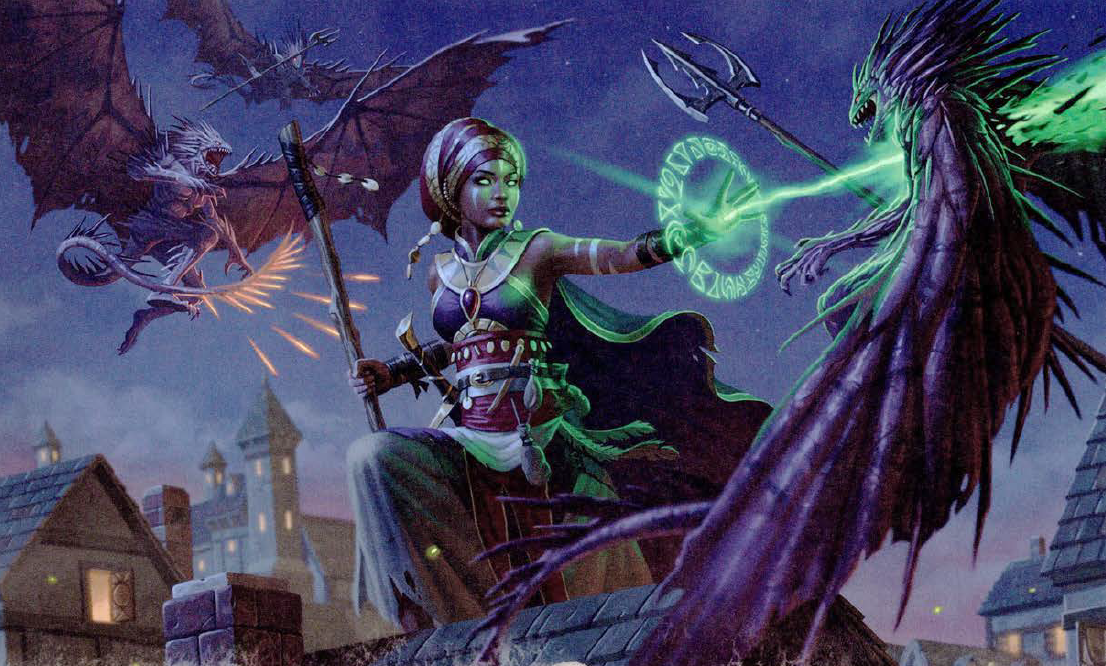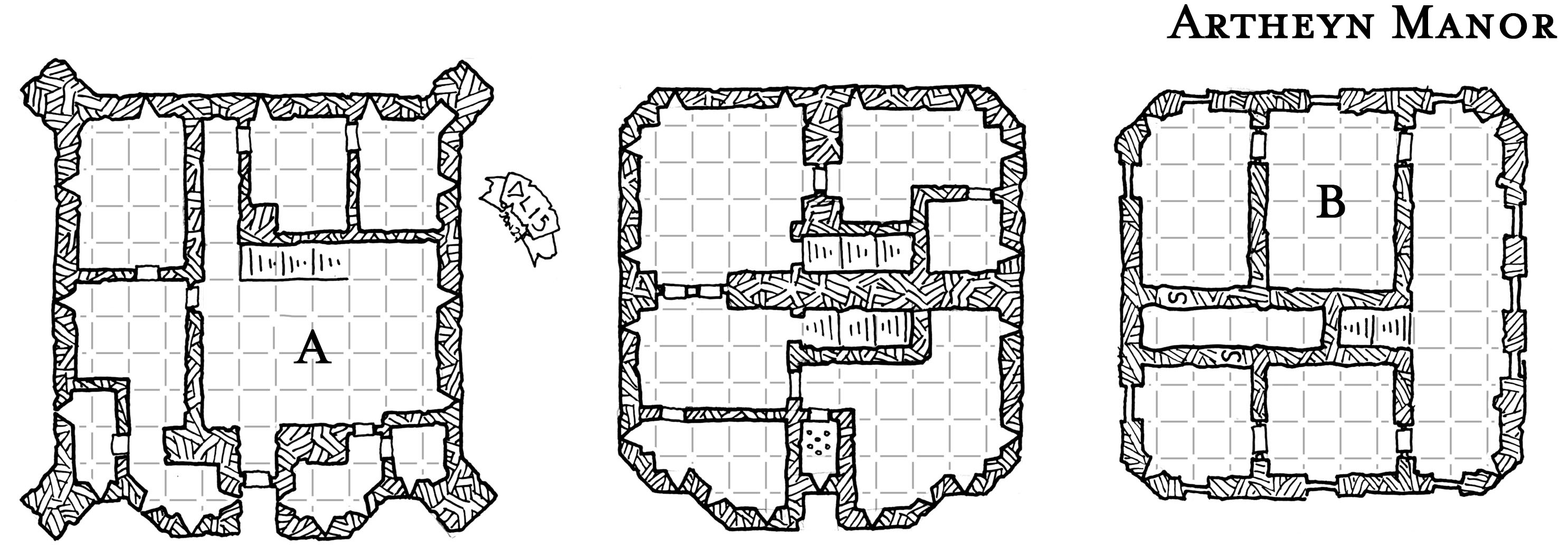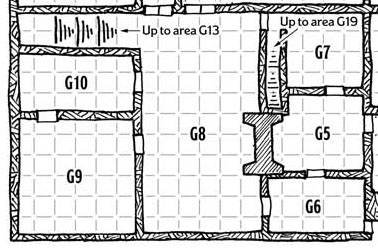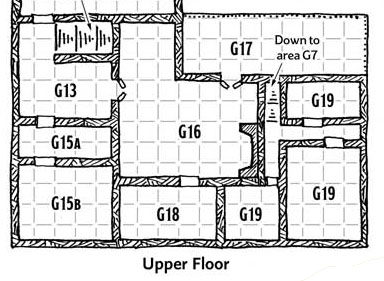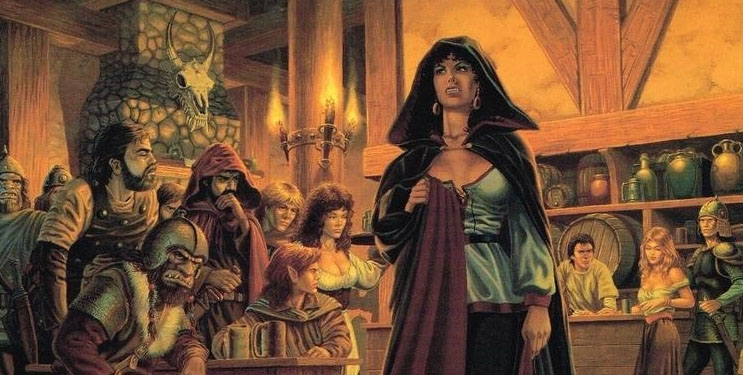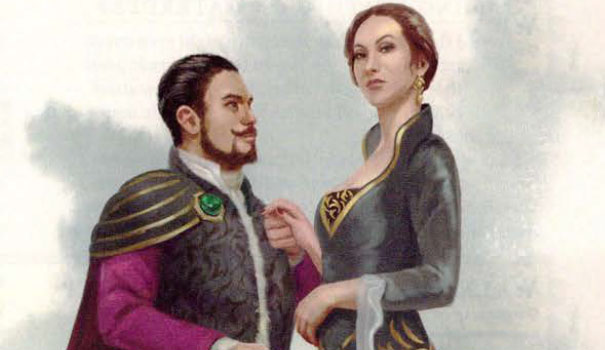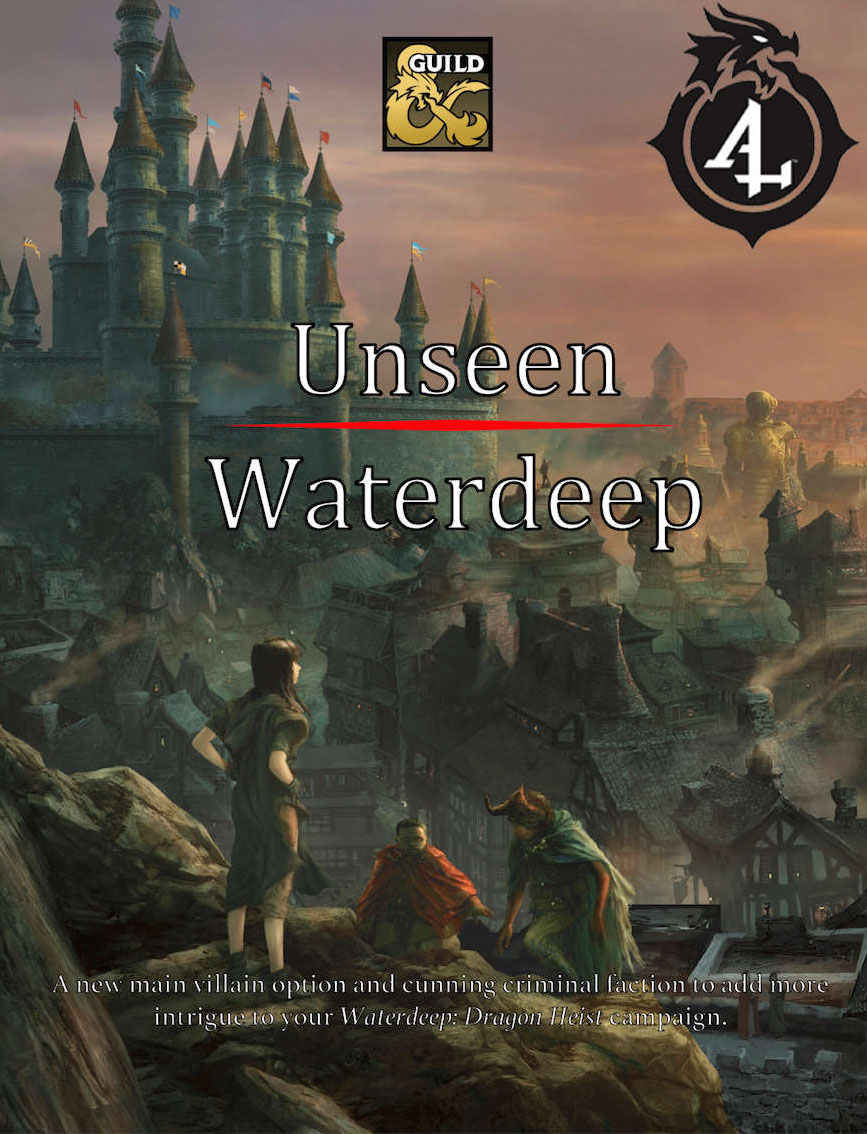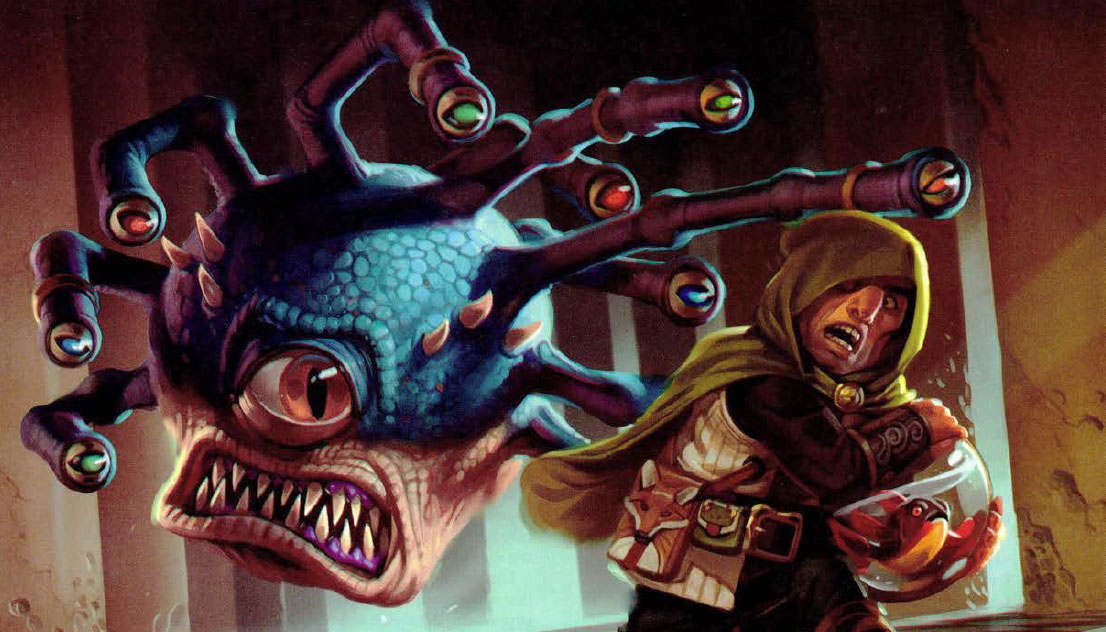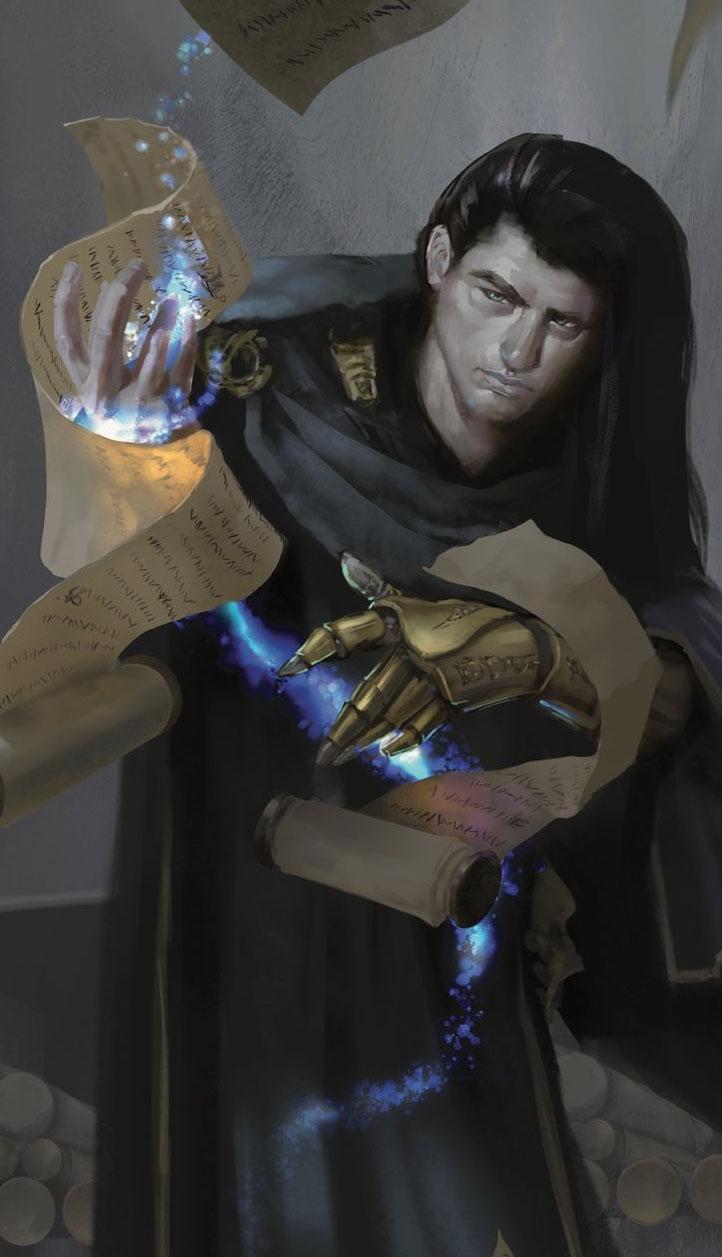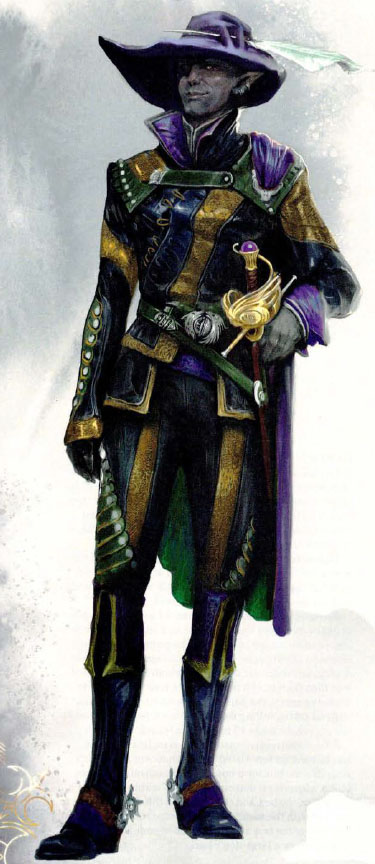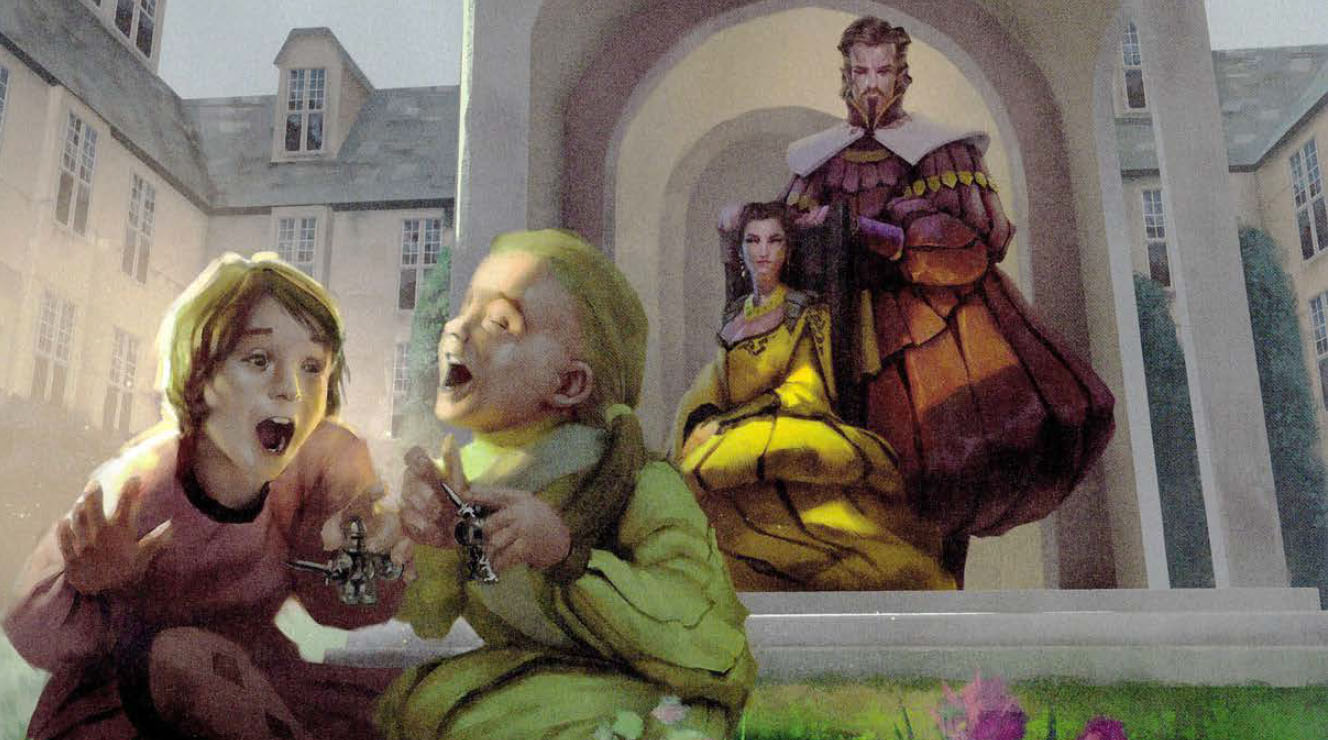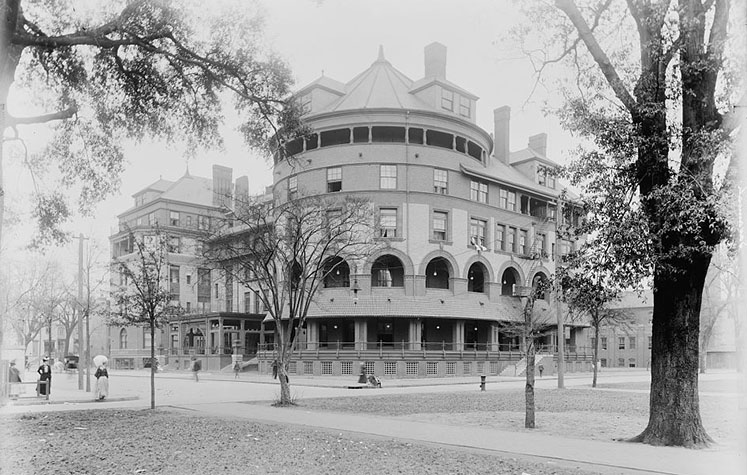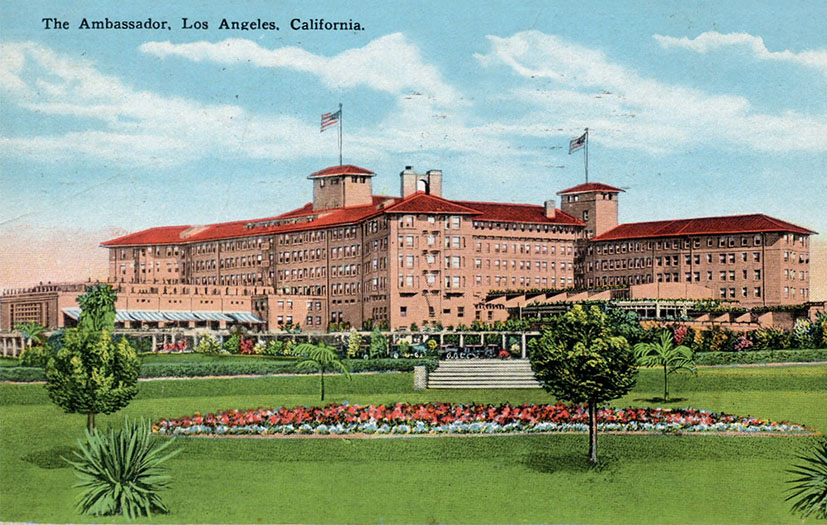The investigation which brings the PCs from the fireball in Trollskull Alley to the Gralhund Villa will be fully described in Part 5. For the moment, however, we do need to establish a few key pieces of revised continuity:
- As mentioned in Part 1, the Gralhund’s nimblewright and the Zhentarim agents tracking Dalakhar are NOT working together.
- The nimblewright uses a necklace of fireballs to launch a fireball which kills Dalakhar and most of the Zhentarim agents, with the exception of Urstul Floxin (who barely survives, but is incapacitated).
- The Gralhund nimblewright dashes forward, rifles through Dalakhar’s pockets, and takes the Stone of Golorr. It then runs off, returning to Gralhund Villa.
- Urstul Floxin is able to identify the nimblewright. The Zhentarim track it back to the Gralhunds and are out for both revenge and the Stone.
- Meanwhile, the PCs will have likely tipped off Jarlaxle and pulled Bregan D’Aerthe into the Grand Game. Jarlaxle and his agents will also know who the nimblewright belonged to.
- Xanathar doesn’t know that the Gralhunds have the Stone, but he has learned that Urstul Floxin, a Zhentarim agent, was present when Dalakhar was killed. The beholder is still not entirely clear who stole the Stone, but he has his agents observing Urstul Floxin and those agents have tracked him to Gralhund Villa.
This sets up the quadpartite confrontation (really quinpartite once you add in the PCs) at the Gralhund Villa.
DESIGN NOTES
The simple goal here is to viscerally evoke the cross-faction conflict of the Grand Game: The first scenario of the campaign features two of the factions (although the PCs only encounter one of them). The climax of the second scenario features three of the main factions plus the Gralhunds (and also the Cassalanters if the PCs are working for them at this point) all coming together in immediate conflict. That’s the essential story of Dragon Heist being told through action, and it sets the stakes for the rest of the campaign.
OBSERVING THE VILLA
The Villa, for our purposes, exists in one of two states when the PCs arrive: Before the Zhentarim Raid and During the Zhentarim Raid. The DM can select which scenario is true based on any number of criteria, but I’m going to use a simple metric: If the PCs arrive during the day, then the Zhentarim raid happens that night. If they arrive at night, then the Zhentarim raid is in progress. (And if, for whatever reason, they specifically decide not to go to the Gralhund Villa after tracking the nimblewright back to it, I’ll trigger the raid a couple days later and have the PCs hear reports of it – either through broadsheets or contacts or simply gossip in their tavern’s common room.)
Before the raid happens (i.e., if the PCs arrive during the day), the Villa is under observation by up to three different factions. If the PCs scout around the Villa, they may be able to spot these teams. The DC for Wisdom (Perception) tests is noted with each faction.
ZHENTARIM WATCHERS (DC 12): Two Zhentarim thugs are located on the roofs of the buildings near the estate, stealthily changing their position from time to time. They have been placed here by Urstul Floxin to make sure that neither the nimblewright, the Gralhunds, nor the Stone of Golorr leave the villa before the raid begins. They have a black flying snake with them to send a message if necessary.
The Zhentarim watchers spotted one of Xanathar’s gazers, but didn’t realize it was watching them (or that it has remained in the area). They are unaware of the presence of Jarlaxle’s team.
XANATHAR’S GAZERS (DC 16): There are four of Xanathar’s gazers in the area. At DC 16, the PCs spot one gazer. They spot an additional gazer for each PC who succeeds on the test or for every 2 points of margin of success.
Xanathar’s agents tracked Urstul Floxin and the Zhentarim watchers to the villa when he gave them their instructions. Xanathar isn’t sure exactly what Floxin wants with the Gralhunds, but he’s installed the gazers to find out.
JARLAXLE’S TEAM (DC 14): If Jarlaxle has been tipped off by the PCs, he has a team holed up in Artheyn Manor across the street from the villa.
The Artheyns are a mercantile family. Radford Artheyn, the patriarch, has packed up the household and temporarily relocated to the Moonshae Isles in pursuit of a rumored vein of black gold in Alaron. (See MOON1-3: Black Gold from the 4th Edition Living Forgotten Realms for more on black gold, although the details aren’t actually important for this scenario.) Drop cloths cover most of the furniture in the three-story house. A watch team has been stationed by the front door (Area A), which is on the opposite side of the house from Gralhund Villa, and the primary observation team is on the top floor (Area B).
Area A: Fel’Rekt Lafeen (drow gunslinger; Dragon Heist, p. 201) and 2 drow.
- A Directive from Jarlaxle lays on a side table. (If the PCs search Artheyn Manor after the raid, Fel’Rekt has carelessly left this behind.) The directive, signed by “Jarlaxle Baenre”, indicates that Fel’Rekt is to keep a watch on the Gralhund Villa and “seize any opportunity to take possession of the Stone of Golorr”. Updates are to be sent twice daily via Fenerus Stormcastle, and someone named Krebbyg has been instructed to pick up messages from Fenerus twice daily for the duration of the Gralhund operation.
- GM Note: Fenerus Stormcastle’s House is a Bregan D’Aerthe outpost, see Part 3.
Area B: Two drow gunslingers and 6 drow.
Jarlaxle’s team are aware of both the Zhentarim watchers and Xanathar’s gazers.
THE VILLA – ADVERSARY ROSTERS
Adversary rosters make it easy for a DM to run dynamic locations in which the action spills over from one room to the next. If you’re not already familiar with their use, I recommend reviewing this article which discusses them in detail.
To use these rosters, simply ignore any references to NPCs in the published key for the Gralhund Villa. If the PCs enter the villa before the Zhentarim raid has begun, you should also obviously ignore any references to corpses or other signs of violence.
GRALHUND VILLA – PCs ARRIVE DURING THE DAY
| 2 Gralhund Guards | Area G1 - Main Gate | |
| 1 Servant (Gardener) | Area G2 - Yard | |
| Stableboy (Ike) + 2 Mastiffs | Area G3 - Coach House | (mastiffs don't obey Ike) |
| Groundskeeper (Hurv) | Area G3 - Bedroom | (sleeping) |
| 12 Gralhund Guards | Area G4 - Barracks | (8 unarmored, 1d4+1 sleeping) |
| 2 Servants (Head Butler + Cook) | Area G6 - Pantry | |
| Servant (Head Maid) | Area G7 - Laundry Room | (keys to all locked doors) |
| 4 Gralhund Guards | Area G8 - Great Hall | |
| 1 Servant (Maid) | Area G9 - Parlor | |
| 1 Servant (Maid) | Area G10 - Trophy Room | |
| Nimblewright | Area G11 - Orond's Study | |
| Orond Gralhund | Area G12 - Family Library | |
| 2 Gralhund Guards | Area G13 - Upstairs Foyer | |
| Yalah Gralhund + Hrabbaz | Area G16 - Master Bedroom | |
| 2 Servants (Nursemaids) | Area G18 - Children's Room | |
| Gralhund Children (Zartan + Greth) | Area G18 - Children's Room | |
| 4 Servants | Area G19 - Servant's Wing | (playing Three-Dragon Ante) |
GRALHUND VILLA – PCs ARRIVE AT NIGHT
| Groundskeeper (Hurv) + 2 Mastiffs | Area G2 - Garden | (in shadow form) |
| Stableboy (Ike) | Area G3 - Bedroom | (sleeping) |
| 2 Zhent Thugs | Area G8 - Great Hall | |
| 4 Zhent Thugs + 4 Gralhund Guards | Area G13 - Upstairs Foyer | (fighting) |
| Urstul Floxin | Area G15a - Guest Suite | (wounded) |
| Orond Gralhund | Area G15b - Guest Suite | |
| Yalah Gralhund + Nimblewright + Hrabbaz | Area G16 - Master Bedroom | |
| Gralhund Children (Zartan + Greth) | Area G18 - Children's Room | |
| 9 Servants | Area G19 - Servant's Wing |
STAT REFERENCE
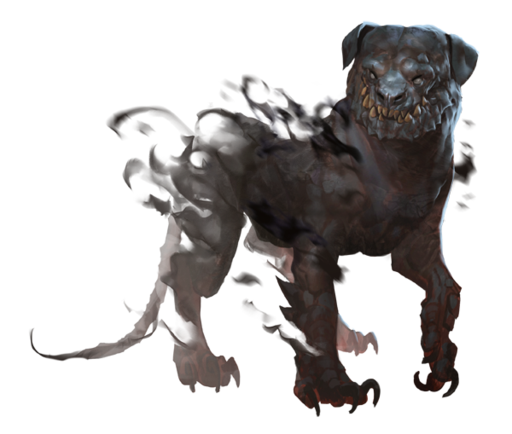 Groundskeeper (Hurv) – cult fanatic, MM p. 345 or shadow, MM p. 269
Groundskeeper (Hurv) – cult fanatic, MM p. 345 or shadow, MM p. 269
Mastiffs – MM p. 332 or shadow, MM p. 269
Servants – commoner, MM p. 345
Gralhund Guards – veteran, MM p. 350
Yalah Gralhund – DH p. 220; noble, MM p. 348
Orond Gralhund – DH p. 213-4; noble, MM p. 348
Urstul Floxin – DH p. 216; assassin, MM p. 343
Zhentarim Thugs – thug, MM p. 350
Flying Snake – MM p. 322
Drow Gunslingers – DH p. 201
Drow – MM p. 126
Gazer – DH p. 203
THE VILLA – MODIFIED KEY
Area G11 – Orond’s Study: The mahogany desk is covered with papers, which consist of the Gralhund Study of the Grand Game (see Part 6D).
Area G12 – Library: Orond was studding A Missive from Castle Ward. He leaves it laying on the arm of one of the library’s chairs if disturbed (by, for example, a Zhentarim strike team breaking into this house).
- A Missive from Castle Ward: “We are now certain that the Second Eye was carried from the warehouse in the Dock Ward to Yellowspire in the Castle Ward. I no longer believe that it remains within Yellowspire, however. After observing the Zhentarim traffic here, I am convinced that they must be using a teleportal within the tower. If we wish to track the Second Eye further, we will need to access that teleportal or otherwise determine where it leads. – Chirada”
Area 15b – Guest Suite: Does not contain a teleportation circle or flying snakes.
THE PCs RAID THE MANSION
If the PCs arrive during the day and raid the mansion before Floxin shows up, what happens?
OBSERVATION TEAMS: Check to see if they spot the PCs’ infiltration. If they don’t, then nothing happens until they do. Then, broadly speaking:
The Zhentarim will send their flying snake to Urstul, who will hastily assemble his team and rush over. He still won’t arrive for 10+2d6 minutes, though, so it’s quite possible the PCs will complete their raid and leave. If that happens and the Zhentarim think they have the Stone, they’ll leave a message drop for Urstul and attempt to follow the PCs to see where they take it. If they don’t think the PCs have the Stone, one of the Zhentarim will follow them (to identify who the new players in the Grand Game are) and the other will maintain observation of the villa.
Xanathar’s Gazers will continue monitoring the situation, with one or more of the gazers following the PCs when they leave.
Jarlaxle’s Team will wait for an opportunity to present itself and then strike at the Stone. That might mean attempting to send a team into the compound (probably heading over the roof and entering through Area 17 – The Balcony), or it might mean waiting until the PCs have the Stone and then attacking them as they leave.
GRALHUND GUARDS: If the alarm is raised, then
- 2 of the guards from Area G8 – Great Hall will move towards the alarm.
- 1d4 rounds later, 4 armored guards from G4 – The Barracks will mobilize. 2 will head towards the alarm; two will move towards Lord Gralhund.
- 1d4 rounds later, the unarmored guards from G4 – Barracks who were NOT asleep will mobilize with weapons but no armor.
- 1d4 rounds later, the unarmored guards from G4 – Barracks who WERE sleeping will mobilize with weapons but no armor.
(It would take unarmored guards 5 minutes to don their chain shirts. They’re not going to wait on it if the villa is under attack.)
Beyond that general response procedure, though, simply use the adversary roster and play the characters appropriately based on the information they have.
OTHER APPROACHES: What about other approaches? For example, what if the PCs knock on the front door? Or bring the City Watch? Broadly speaking, if the compound seems threatened by armed force, similar responses will be taken. If a peaceful approach is being taken, successful Charisma checks may allow PCs to meet with Lord Orond. (Lady Yalah will not put in an appearance; she stays with the Stone upstairs.)
ZHENTARIM RAID TIMELINE
The night-time adversary roster assumes that the PCs arrive on the scene during the night, with the Zhentarim raid taking place in media res. If the PCs instead arrive during the day and settle down as their own observation team, then they’ll be able to watch the raid play out in real time.
FLOXIN’S PLAN: Urstul wants to enter the house quietly through G6 – Pantry, make a rush through G8 – The Great Hall, go up the stairs, and capture Lord Orond, Lady Yalah, and/or the children before the guards can fully mobilize. With hostages in hand, he believes they can negotiate for the Stone of Golorr and then leave.
This is what their raid looks like, broadly speaking (assuming the PCs don’t intervene):
- Urstul Floxin and 8 Zhents in black leather armor rendezvous with the 2 watchers and then all of them approach along the villa’s rear wall and pick the lock to the Pantry (G6).
- Inside they are surprised to discover two servants (the head butler and the cook) using the pantry for an illicit, late night romantic liaison.
- The halfling cook makes a run for the Kitchen (G5), screaming bloody murder. Which is, in fact, what the Zhents do: They murder both servants.
- The cook’s screams, however, alert the head maid who was working in the Laundry (G7). She comes to see what the fuss is all about, entering the kitchen to see the Zhents cut down the cook in the opposite doorway. She turns and runs back through the laundry screaming.
- Floxin curses and tells half of his men to chase her down. They catch up with her on the backstairs to the Servant’s Quarters (G19) and kill her. A couple of other servants who were coming down the stairs run back up, raising the alarm, and the servants eventually barricade themselves.
- Meanwhile, the head maid’s screams have alerted the guards in the Great Hall (G8). One of them runs out the front doors and circles around to the Barracks (G4) to raise the rest of the guard. The other three move into G7 and begin fighting the Zhents there.
- This actually works to Floxin’s advantage slightly, leaving the Great Hall (G8) empty. He and his force rush from the Kitchen (G6) into the south end of the Great Hall (G8), but before they can head for the stairs, two guards on patrol in the Parlor (G9) walk out the door. Urstul and his men attack, driving the guards back into G9 and killing them.
- Lord Orond emerges from the Library (G12), where he’s been studying late. Urstul, still in the hall just outside G9 sees him, gives a cry. Lord Orond flees up the stairs while Urstul and his men give chase.
- The guards fighting the Zhents in the Laundry (G7) are mortally wounded and fall back almost simultaneously into G8. The Zhents they were fighting give pursuit and kill them.
- Upstairs the guards in the Upstairs Foyer (G13) have already barricaded the doors to the Master Bedroom (G16) where Lady Yalah and the children are. So when Lord Orond comes rushing upstairs, one of the guards ushers him into the Guest Suite (G15). The guard is killed by Urstul Floxin as he shuts the door on his lord.
- Meanwhile, guards are pouring out of the Barracks (G4) and entering the house through both the Great Hall (G8) and the Kitchen (G5). They engage the second Zhent force in G8.
- Upstairs things are looking bad for the Gralhunds, with Urstul’s Zhents dispatching the other guard in G13. The Zhents downstairs hold the line and manage to kill a total of eight guards there, but after two Zhents are killed they’re forced into a fighting retreat up the stairs.
- A furious melee breaks out at the top of the stairs while Urstul desperately tries to break down the door in the Guest Suite (G15b) to reach Lord Orond and take him hostage. Some of the Zhents manage to break down the door to the Master Bedroom (G16), but are then forced to turn and fight as the guards come pouring up the stairs.
This is the point in time represented by the PCs Arrive At Night roster. At this point, as described in the original adventure key, there are the following corpses:
- G6 – head butler and cook
- G7 – head maid on the stairs up to G19
- G8 – 8 guards, 2 Zhent
- G9 – 2 guards
- G13 – 6 guards, 2 Zhents
(Note: There’s nothing special about this point in time. If it seems more dramatically appropriate, you can have the PCs arrive at any point during this timeline, although running things from the key will be slightly more complex as you’ll want to adjust the corpses, etc. accordingly in real time. Tracking the PCs attempting a stealthy infiltration from the north at the exact same time that Floxin and his team are infiltrating from the south can be a lot of fun!)
If the PCs haven’t interfered (and don’t interfere going forward) here’s what the rest of the raid looks like:
- Jarlaxle’s team goes into motion: Fel’Rekt Lafeen and 6 drow cross the roof of Gralhund Villa, taking up a position immediately above the Balcony (G17). The two drow gunslingers and 2 more drow move across the roofs and take up a position opposite the large windows of the Upstairs Foyer (G13).
- The Gralhund Guards manage to kill the rest of the Zhents. At this point, however, there are only four guards left.
- The drow gunslingers sniper the Gralhund guards through the window. Simultaneously, Fel’Rekt and his team drop onto the Balcony (G17) and break open the doors.
- Lady Yalah flees into the Children’s Room (G18). While his drow go to G15 and collect Lord Orond, Fel’Rekt spends 6 rounds dueling Hrabbaz, eventually killing him.
- Lord Orond is dragged into G16 and Fel’Rekt negotiates with Lady Yalah through the door. Lady Yalah eventually breaks and, sobbing, gives Fel’Rekt the Stone of Golorr. He and his team flee back the way they came as the City Watch comes bursting into the house on the lower level.
BUT WHAT ABOUT THE PCs?
With all that being said, it’s considerably more likely that the PCs will intervene at some point. Once that happens, of course, everything is probably going to change. It’s impossible to speculate on that new outcome because the situation is so volatile and there are so many different ways the PCs might go in the confusion and chaos of the situation they find themselves in: Do they help the Zhents? The Gralhunds? Do they end up fighting Fel’rekt’s people on the roof and giving the Gralhunds a chance to escape or for the City Watch to arrive? Ultimately, you just have to play and find out!
There are a few points to make, however:
The failure of the Zhentarim is not foreordained. If the PCs draw off some of the reinforcements from the barracks, for example, it’s quite possible that the Zhents are able to kill the guards and take control of the Gralhund family.
If circumstances change, Lady Gralhund may be presented with an opportunity to give the Stone of Golorr to the nimblewright and have the construct escape with it.
Jarlaxle’s Team will look for an opportunity to intervene in Bregan D’Aerthe’s favor. In the default raid that comes quite late, but once the PCs get involved Fel’rekt may decide to have his drow crash the party much earlier. Or they might wait and attack the PCs after they leave.
Xanathar’s Gazers will not intervene. But they will attempt to follow anyone and everyone leaving the scene afterwards.
WHAT HAPPENS TO THE STONE?
With all that being said, the EXPECTED OUTCOME of the Gralhund Villa sequence in this remix is for the PLAYER CHARACTERS TO HAVE THE STONE OF GOLORR.
(This is a really significant change to the campaign as published, so I’m putting it in bold here.)
ROOFTOP CHASE: If the PC’s DON’T have the Stone of Golorr, then it is likely that they’ve spotted someone fleeing the scene with it. This will probably trigger a rooftop chase, for which you can use the Rooftop Chase Complications from p. 72 of Dragon Heist.
AND NOW THE GAZERS: If you end up in a rooftop chase – here or anywhere else in the adventure – it will be a really cool visual for the PCs to suddenly see multiple gazers come swooping out of the darkness.
This is the scenario – the Stone of Golorr known and in the open – that Xanathar will have his gazers get involved. You might use this to cripple those carrying it, allowing the PCs to catch up. If circumstances allow, Xanathar might also be able to send a Response Team (see Part 3C) to intercept the chase, turning it into a three-way brawl for control of the Stone.
THE STONE IS LOST: If that fails (or the PCs don’t see the Stone leave or choose not to pursue it), figure out where it goes. Transport to a Faction Outpost (see Part 3) and then to a Lair (see Part 4) is the most likely outcome for any of the factions.

